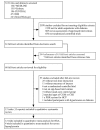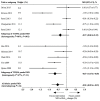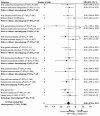Mobile App-Based Interventions to Support Diabetes Self-Management: A Systematic Review of Randomized Controlled Trials to Identify Functions Associated with Glycemic Efficacy
- PMID: 28292740
- PMCID: PMC5373677
- DOI: 10.2196/mhealth.6522
Mobile App-Based Interventions to Support Diabetes Self-Management: A Systematic Review of Randomized Controlled Trials to Identify Functions Associated with Glycemic Efficacy
Erratum in
-
Correction: Mobile App-Based Interventions to Support Diabetes Self-Management: A Systematic Review of Randomized Controlled Trials to Identify Functions Associated with Glycemic Efficacy.JMIR Mhealth Uhealth. 2018 Jan 15;6(1):e20. doi: 10.2196/mhealth.8789. JMIR Mhealth Uhealth. 2018. PMID: 29334479 Free PMC article. No abstract available.
Abstract
Background: Mobile health apps for diabetes self-management have different functions. However, the efficacy and safety of each function are not well studied, and no classification is available for these functions.
Objective: The aims of this study were to (1) develop and validate a taxonomy of apps for diabetes self-management, (2) investigate the glycemic efficacy of mobile app-based interventions among adults with diabetes in a systematic review of randomized controlled trials (RCTs), and (3) explore the contribution of different function to the effectiveness of entire app-based interventions using the taxonomy.
Methods: We developed a 3-axis taxonomy with columns of clinical modules, rows of functional modules and cells of functions with risk assessments. This taxonomy was validated by reviewing and classifying commercially available diabetes apps. We searched MEDLINE, EMBASE, the Cochrane Central Register of Controlled Trials, the Chinese Biomedical Literature Database, and ClinicalTrials.gov from January 2007 to May 2016. We included RCTs of adult outpatients with diabetes that compared using mobile app-based interventions with usual care alone. The mean differences (MDs) in hemoglobin A1c (HbA1c) concentrations and risk ratios of adverse events were pooled using a random-effects meta-analysis. After taxonomic classification, we performed exploratory subgroup analyses of the presence or absence of each module across the included app-based interventions.
Results: Across 12 included trials involving 974 participants, using app-based interventions was associated with a clinically significant reduction of HbA1c (MD 0.48%, 95% CI 0.19%-0.77%) without excess adverse events. Larger HbA1c reductions were noted among patients with type 2 diabetes than those with type 1 diabetes (MD 0.67%, 95% CI 0.30%-1.03% vs MD 0.36%, 95% CI 0.08%-0.81%). Having a complication prevention module in app-based interventions was associated with a greater HbA1c reduction (with complication prevention: MD 1.31%, 95% CI 0.66%-1.96% vs without: MD 0.38%, 95% CI 0.09%-0.67%; intersubgroup P=.01), as was having a structured display (with structured display: MD 0.69%, 95% CI 0.32%-1.06% vs without: MD 0.16%, 95% CI 0.16%-0.48%; intersubgroup P=.03). However, having a clinical decision-making function was not associated with a larger HbA1c reduction (with clinical decision making: MD 0.18%, 95% CI 0.21%-0.56% vs without: MD 0.61%, 95% CI 0.27%-0.95%; intersubgroup P=.10).
Conclusions: The use of mobile app-based interventions yields a clinically significant HbA1c reduction among adult outpatients with diabetes, especially among those with type 2 diabetes. Our study suggests that the clinical decision-making function needs further improvement and evaluation before being added to apps.
Keywords: classification; diabetes mellitus; mHealth; mobile applications; mobile apps; mobile health.
©Yuan Wu, Xun Yao, Giacomo Vespasiani, Antonio Nicolucci, Yajie Dong, Joey Kwong, Ling Li, Xin Sun, Haoming Tian, Sheyu Li. Originally published in JMIR Mhealth and Uhealth (http://mhealth.jmir.org), 14.03.2017.
Conflict of interest statement
Conflicts of Interest: None declared.
Figures






References
-
- Yang G, Wang Y, Zeng Y, Gao GF, Liang X, Zhou M, Wan X, Yu S, Jiang Y, Naghavi M, Vos T, Wang H, Lopez AD, Murray CJ. Rapid health transition in China, 1990-2010: findings from the Global Burden of Disease Study 2010. Lancet. 2013 Jun 8;381(9882):1987–2015. doi: 10.1016/S0140-6736(13)61097-1.S0140-6736(13)61097-1 - DOI - PMC - PubMed
-
- American Diabetes Association . Standards of medical care in diabetes-2017. Diabetes Care; 2017. Jan, [2017-03-11]. http://professional.diabetes.org/sites/professional.diabetes.org/files/m... .
-
- Bragg F, Holmes M, Iona A, Guo Y, Du H, Chen Y, Bian Z, Yang L, Herrington W, Bennett D, Turnbull I, Liu Y, Feng S, Chen J, Clarke R, Collins R, Peto R, Li L, Chen Z, China Kadoorie Biobank Collaborative Group Association between diabetes and cause-specific mortality in rural and urban areas of China. JAMA. 2017 Dec 17;317(3):280–9. doi: 10.1001/jama.2016.19720.2598266 - DOI - PMC - PubMed
-
- Yang W, Lu J, Weng J, Jia W, Ji L, Xiao J, Shan Z, Liu J, Tian H, Ji Q, Zhu D, Ge J, Lin L, Chen L, Guo X, Zhao Z, Li Q, Zhou Z, Shan G, He J, China National Diabetes and Metabolic Disorders Study Group Prevalence of diabetes among men and women in China. N Engl J Med. 2010 Mar 25;362(12):1090–101. doi: 10.1056/NEJMoa0908292.362/12/1090 - DOI - PubMed
-
- Xu Y, Wang L, He J, Bi Y, Li M, Wang T, Wang L, Jiang Y, Dai M, Lu J, Xu M, Li Y, Hu N, Li J, Mi S, Chen C, Li G, Mu Y, Zhao J, Kong L, Chen J, Lai S, Wang W, Zhao W, Ning G, 2010 China Noncommunicable Disease Surveillance Group Prevalence and control of diabetes in Chinese adults. JAMA. 2013 Sep 04;310(9):948–59. doi: 10.1001/jama.2013.168118.1734701 - DOI - PubMed
LinkOut - more resources
Full Text Sources
Other Literature Sources
Research Materials
Miscellaneous

